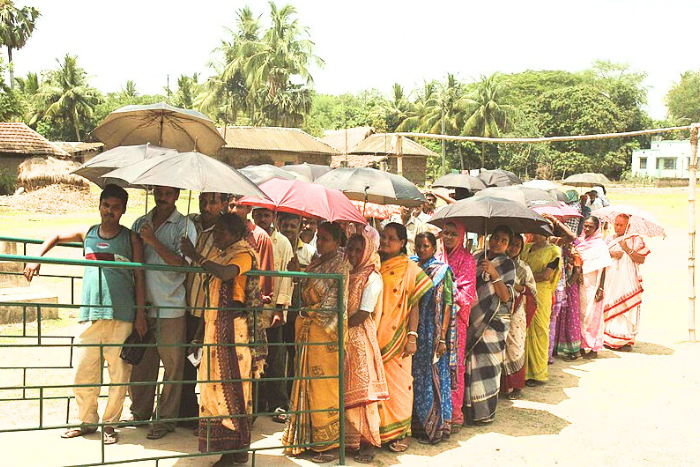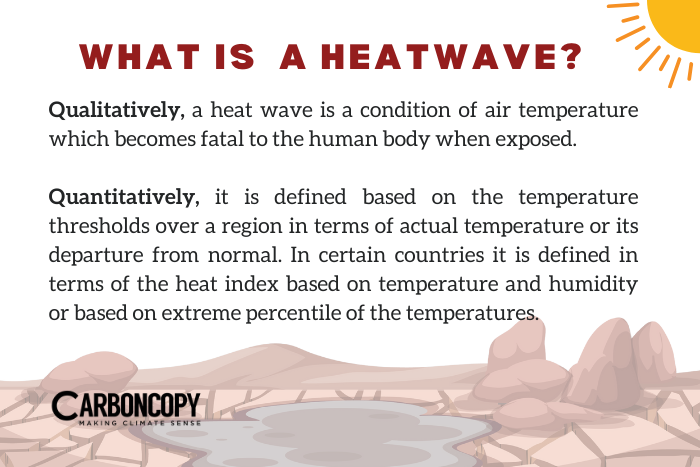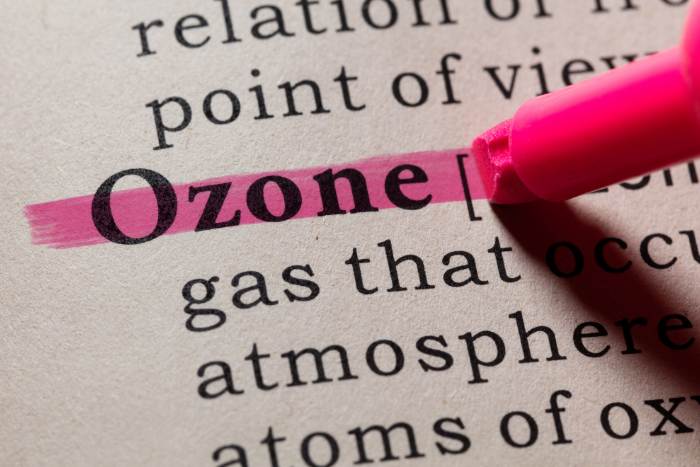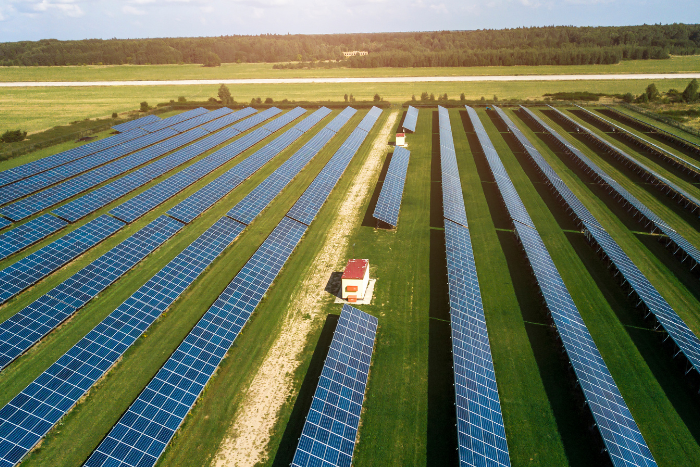


While the Election Commission of India has constituted a ‘task force’ to help voters deal with the massive heatwave during the ongoing general elections, whispers are slowly turning into demands for the democratic process to be held in less harsh climatic conditions. Read more
The rising intensity of heatwaves has triggered a debate about whether India's general elections can be held in better weather conditions. Photo: Election Commission of India/Wikimedia Commons
Voter burnout: Is India’s general election process seeing its last summer?
While the Election Commission of India has constituted a ‘task force’ to help voters deal with the massive heatwave during the ongoing general elections, whispers are slowly turning into demands for the democratic process to be held in less harsh climatic conditions
The world’s largest election is currently underway. India is giving nearly a billion (950 million) citizens the chance to exercise their right to vote a government of their choice into power. But candidates have been met with an unexpected adversary—extreme weather. The two-and-a-half-month electoral process—voting takes place in seven phases between April 19 and June 1—coincides with a season of extreme heat waves this year, far worse than 2023, which was the warmest year on record till date.
The impact–some states have recorded temperatures hovering around 42°C-45°C—has been a great leveller. It has spared neither the voter nor the candidates. Last week, Union minister Nitin Gadkari fainted during an election rally in Maharashtra. Voters facing the brunt of the heat made headlines in the national and international media.
As a result, the democratic process has taken a major hit. Kerala, which is currently in the midst of an intense heatwave, reported nearly 10 deaths following heat strokes, some of whom were reportedly standing in long queues to vote. Nineteen of the 20 constituencies in Kerala reported a big drop in turnout—71% against 77.8% in 2019.
With such unprecedented heat, the Election Commission of India (ECI) has quickly constituted a ‘task force’ to deal with the situation for the first time in India’s electoral history. It will provide a “specialised forecast” before each polling day. But such band-aid measures have limited impact. The rising intensity of heatwaves has triggered a debate about whether India’s general elections can be held in better weather conditions. Experts said adjusting the schedule for a smooth organisation of the election process isn’t unusual and it can be done by political consensus or through a law in Parliament. So will this be the last summer election that India can afford to have?

Wave of the future
The nodal weather agency of the country, India Meteorological Department (IMD), has predicted more than double the normal heatwave days from April till June. In fact, the first spell of heatwave has already made an appearance as early as the beginning of April. Notedly, heatwaves have claimed more lives in India than other natural hazards, with the exception of tropical cyclones. Fresh studies show that India has seen more than 24,000 deaths due to heatwaves since 1992. This, coupled with endless predictions of future temperature spikes globally, may prove to be devastating for India.
One can argue that a dip recorded in voter turnout can’t be blamed on heatwaves entirely, but the ECI has still taken serious note. It held a meeting with all stakeholders, including IMD officials, to “mitigate the risks” because of heatwaves so that people are not deterred from coming out to vote. Before the next phase of elections, which is on May 7, when 94 seats of the Lok Sabha go to polls, the IMD has issued a heatwave warning.
Last year, on April 16, a heatwave had claimed 13 lives at a public event in Navi Mumbai and over 600 hospitalisations were reported. The country is likely to experience 10 to 20 days of heatwaves in different parts against a normal of 4 to 8 days. The areas most prone to increased heatwaves will be Gujarat, Madhya Maharashtra, north Karnataka followed by Rajasthan, Madhya Pradesh, North Chhattisgarh, Odisha and Andhra Pradesh, according to the IMD.
Since 2004, the general elections have been held in the summer season in India, but this time may be the hardest for the election staff, security personnel, candidates and electors. Two phases of the elections are over and five more rounds will be held on May 7, 13, 20, 25 and June 1.
The ECI’s heat task force consists of the officials from ECI, IMD, NDMA and Union health ministry. The task force will review the impact of the heatwave and humidity before each polling day and provide a “specialised forecast”.
Professor Dileep Mavalankar, director of Indian Institute of Public Health, Gandhinagar, said a close look on the everyday mortality during this heatwave season is very important.
“They [ECI] should also include the registrar of birth and death of each place [going to polls in different phases] in this task force. Because unless you know how many people have died in a district, and get the information of abnormal mortalities in a specific area, you cannot assess the ground situation. Therefore, the Registrar General of India [RGI] should also be included (in the task force),” Mavalankar told Carboncopy.
Heatwave deaths are not easy to classify and there is no analysis or record of death due to heatstroke in India. The only way to understand the impact of a heatwave is to look at the mortality data every day.
Mavalankar said, “Like the IMD gives you everyday temperature, the RGI must give data of everyday deaths and this will help understand the situation [of heatwave]. A daily bulletin about the number of patients admitted in the hospitals, based on the symptoms of patients, can also help to know how many people suffered from the heatwave.”
So can election dates be shifted?
Research said the “heatwave-hazard risk would significantly worsen in all districts under enhanced global warming” in the future. Therefore, we may face even tougher conditions in the summers to come. Even if political parties and general electors exercise caution during campaigning and voting, the impact of the heatwave on the democratic process cannot be wished away completely.
India being a federal democracy has a general election—held every five years—along with several smaller state-level elections interspersed between those years. Former Chief Election Commissioner (CEC) of India OP Rawat suggests that a meeting of all political parties should be convened and a consensus should be arrived at on the timing of state and central elections.
“There is a six-month window [as per the Constitution] to hold parliamentary elections,” he said, while highlighting that a few state elections always take place just months before the general elections.
“To avoid such a situation in future, the election commission must call for an all-party meet where it could collectively agree on delaying the state elections by two months and holding the parliamentary elections at a preferred time during the six-month window. For example, for the next general elections, which would be in 2029, the window falls between January 1 and June 30. Spring [around February-March] is the best time to hold the elections. Or else, there should be an amendment in the law that empowers the EC to conduct the state assembly elections a little early,” he said.
Jagdeep Chhokar, founding member of Association of Democratic Reform, also advocates for a change of time and a shorter election schedule as well. “The Constitution provides a provision for this and elections can be convened six months before the term of the ongoing Parliament is over. For a healthy democracy, the ECI has to look at the convenience, comfort and preference of people at large, not only of the various political parties and governments. In the wake of this adverse climate situation, these elections could have been held three months earlier,” Chhokar said.
Unusual heat now a norm
Scientists across the world have been warning against the unprecedented rise in global warming. The planet has warmed far faster in the past 50 years than at any point in at least the past 2,000 years. The Earth’s temperature has risen by an average of 0.11°F (0.06°C) per decade since 1850, or about 2°F in total. The rate of warming since 1982 is more than three times as fast: 0.36° F (0.20° C) per decade.
Unusual heat has now become a common phenomenon. The 10 warmest years in history have all occurred in the past decade (2014-2023). The year 2023 has been the warmest, superseding the year of 2016.
According to the combined data from NOAA (National Oceanic and Atmospheric Administration) and NASA (National Aeronautics and Space Administration), 2023 saw the highest global surface temperature in the 144-year record at 1.4°C (2.52°F), which was above the early industrial (1881-1910) baseline average.
Impacting people, elections and the economy
Apart from health, heat waves also have socio-economic impact as it leads to increased energy consumption, reduce crop yields, increase water loss and intensify droughts or forest fires. Soaring mercury can cause disruptions in critical infrastructure networks and lower labour productivity.
According to a study, India currently loses around 259 billion hours annually due to the impacts of humid heat on labour, up from a previous estimate of 110 billion hours. In terms of changes, in the first 20 years of this century, India lost 25 billion more hours annually compared to the previous 20 years. Also, agricultural labour capacity in India would decrease by 17% if warming continues to 3°C and to 11% if emission cuts are accelerated across the country.
Heat action plans still a work in progress
With the probability of heatwaves increasing dramatically in coming years, Heatwave Action Plans (HAP) have become a need of the hour. They are defined as the comprehensive extreme heat early warning systems and preparedness plans. These plans can also be considered as the country’s primary policy response to economically damaging and life threatening heatwaves.
The first Heat Action Plan was launched in 2013 by the Ahmedabad Municipal Corporation, which went on to become a template for not only India, but also the world. India’s national government is working with 23 heat wave-prone states and over 130 cities and districts to develop and implement HAPs across the country.
However, according to findings of a recent report on their effectiveness, almost all HAPs are inadequate in identifying and targeting vulnerable groups. HAPS are underfunded, lack transparency and have a weak legal basis. It also stated that most HAPs are not tailored to the local context and have an oversimplified view of the hazard.
Abhiyant Tiwari, Lead, Climate Resilience and Heath, NRDC India says, “We notice that there are gaps in financing and institutionalisation of the HAPs, but the good part is that those gaps are being identified and being addressed. Also, from the preparedness and response plan, only the country is moving towards the long-term majors.”
Dealing with heatwaves is a different process from managing other disasters like earthquakes and floods. Experts advocate more microlevel planning where concern for vulnerable communities are addressed adequately. For this, the hotspots for heatwave impact should be identified.
“The HAP has to be very localised and decentralised. If I talk about early warning then you see that the temperature at which the people living in Srinagar are affected is totally different from the temperature for the people of Chandrapur and Jalgaon. People in Vidarbha in Maharashtra may be comfortable at 40°C, but this won’t be the case in mountainous regions,” Tiwari Told the CarbonCopy.
Mavalankar who spearheaded the first HAP of India in 2013, says without a focussed approach, adequate financing and public awareness, the action plans will prove to be just paper tigers.
“There is more progress on paper than in reality. This is partly because there is no budget allocated. Half of the action is public awareness and you need massive advertising to make people aware. But have you seen any advertisements about protection from heatwaves? This is because there is no budget for that. Particularly when there is an election process of this scale underway, you need more awareness campaigns so that people know how to protect themselves from heat,” Mavalankar said.
In West Bengal, Kalaikunda at 45.8°C recorded the highest maximum temperature followed by Panagarh at 44.6ºC.
Heatwave: Bengal, Odisha on red alert, even Kerala backwaters, Ooty and Bengaluru sizzle
Heatwaves have spread across the country with the India Meteorological Department (IMD) sounding a ‘Red alert’ in 8 districts of Bengal and in Odisha and Bihar, at least till Thursday. In West Bengal, Kalaikunda at 45.8°C recorded the highest maximum temperature followed by Panagarh at 44.6ºC. Bengal and Odisha are also experiencing warm night conditions and high relative humidity of around 50% to 75% in the afternoon, creating a deadly mix of extremely hot, humid days and nights, HT reported.
Areas that usually don’t experience heat waves have come into its grips: parts of Kerala, resort towns of Ooty (Tamil Nadu), Matheran (Maharashtra) in the Western Ghats, and Bengaluru, are facing temperatures between 38-39°C, HT reported, adding that 186 of the 191 seats, where polls are due in the next two phases, will have peak temperatures above 35°C in the next five days. Around 136 constituencies may go above 40°C and impact voter turnouts, which have been low in the first two phases.
Mumbai and its adjoining areas witnessed heatwave conditions, with daytime temperatures breaching the 37-degree mark. The IMD Santacruz observatory recorded maximum temperatures of 38.1°C on April 28, which was 4.4°C above normal.
The Election Commission ordered Assured Minimum Facilities (AMF) at polling stations such as water and shade, tap facility for drinking water or drinking water pots and environment-friendly disposable glasses may be made available for drinking water.
Uttarakhand records highest number of large forest fires in India in last week of April
Uttarakhand recorded the highest number of large forest fires in the country between April 23 and April 30, according to Forest Survey of India (FSI) data. The state recorded 201 large forest fire incidents during this period compared to 11 large forest fire incidents in the same period last year. Major forest fires continue to rage in different parts of the state. The state continues to battle the menace, which threatens biodiversity as well as local communities, despite advancements in satellite-based technologies aiding real-time monitoring by the state forest department.
Unseasonal rains damage sugarcane, mangoes, grapes and wheat crops in Marathwada and Vidarbha
Parts of Vidarbha and Marathwada experienced unseasonal rain, thunder and hailstorms causing heavy agricultural losses. The heaviest rain was registered in Yavatmal district. Nagpur and Wardha reported 7 mm and 3 mm rainfall on respectively until April 11. Vidarbha recorded 10.6 mm rainfall between April 4 and 10, whereas Marathwada recorded only 1.3 mm rainfall (below normal by 18%). Reportedly, crops such as wheat, sugarcane, vegetables and fruits (mangoes, grapes and lemons) suffered extensive damage in Vidarbha and Marathwada, HT reported.
As per the IMD, the maximum temperature in Vidarbha dropped 11-14°C below normal, but central Maharashtra constantly recorded up to 2.5°C above normal (Pune, Shivajinagar recorded a maximum temperature of 39°C).
Climate change: Extreme droughts and rain events dodge the IMD predictions ?
The India Meteorological Department (IMD), only for the second time in the 21st century, has predicted an above-normal monsoon in 2024, reported the Mint. The total rainfall between June and September is estimated at 106% of the long-period average (LPA), the IMD said. The newspaper said the last time it predicted above-normal monsoon, in 2016, the rainfall ended up being much lower (97.4%). Analysing the data, the outlet said the IMD’s biggest under-prediction of rainfall (outside of the acceptable range) also came in the past five years. This happened thrice between 2019 and 2023, with the biggest miss in 2019, when the actual rainfall was 110.4% of LPA, against a prediction of 96% of LPA. Of late, the country has been witnessing growing instances of extreme weather conditions.
The newspaper said the IMD has been fairly successful in predicting normal monsoons, but the real challenge lies in predicting droughts and extreme rainfall. Since 2001, the country has had five deficient-rainfall years (2002, 2004, 2009, 2014 and 2015), out of which four ended with droughts, In the first three of these years, IMD had predicted a normal rainfall, over-projecting with an average error of nearly 18% of LPA. In 2014 and 2015, the error stood around 7%. Out of the eight normal-monsoon years since 2001, IMD got it right five times, under-projected twice and over-projected just once.
Hundreds of glacial lakes expanding in Himalayan region a ‘major risk’: ISRO
Over one in every four glacial lakes larger than 10 hectares in area in the Himalayas have grown in size since 1984, increasing the risk of a glacial lake outburst flood or GLOF, reported HT. Long-term satellite imagery covering the Himalayas revealed that of the 2,431 glacial lakes larger than 10 hectares in area identified in 2016-17, 676 glacial lakes have expanded notably since 1984. The Indian Space Research Organisation said 130 of the 676 are within India, with 65, seven, and 58 lakes located in the Indus, Ganga, and Brahmaputra River basins, respectively.
The agency pointed out that long-term changes in the Gepang Gath glacial lake (Indus River Basin) at an elevation of 4,068 m in Himachal Pradesh, shows a 178% increase in size from 36.49 to 101.30 hectares between 1989 and 2022. Its a major risk that can potentially affect the Manali Leh highway and population downstream, the ISRO warned.
Extreme Dubai rainfall linked to climate change, not cloud seeding: Scientists
It is misleading to link extreme rainfall that struck Dubai nearly two weeks ago with cloud seeding, scientists said. The rainfall triggered the worst flooding in over seven decades in one of the world’s most advanced but arid cities. The intensity of the rainfall sparked speculation that cloud seeding may have led to it, prompting climate scientists to underline the climate change link to it, reported HT.
The newspaper quoted Friederike Otto, a senior lecturer at the Imperial College London’s Grantham Institute – Climate Change and the Environment stating that “Cloud seeding cannot create clouds from nothing that encourages water…already in the atmosphere to condense faster and drop water in certain places…first you do need moisture. Without it, there would be no clouds. Even if cloud seeding did encourage clouds around Dubai to drop water, the atmosphere would have likely been carrying more water to form clouds in the first place because of human-induced climate change.”
“If humans continue to burn oil, gas, and coal, the climate will continue to warm, rainfall will continue to get heavy and people will continue to lose their lives in floods.” Otto concluded.
Floods swamp southern China, spark extreme weather fears
Guangdong, the most populous province in southern China, has been battered by unusually heavy, sustained and widespread rainfall, with powerful storms ushering in an earlier-than-normal start to the province’s annual flooding season in May and June, Reuters reported. The heavy rain killed four people, with 10 others remaining missing in the province. The newswire said weather events in China have become more intense and unpredictable because of global warming, scientists say, with record-breaking rainfall and drought assailing the world’s second-largest economy, often at the same time.
9 million Asians were hit by 79 climate-related disasters in 2023: WMO
Asia remained the world’s most disaster-hit region from weather, climate and water-related hazards in 2023, states a new report from the World Meteorological Organization (WMO). The highest number of recorded deaths and financial losses were because of floods and storms, while the effects of heatwaves were increasingly severe.
The State of the Climate in Asia 2023 report highlighted the accelerating rate of key climate change indicators such as surface temperature, glacier retreat and sea level rise. In Asia, there were 79 recorded catastrophes linked to hydro-meteorological hazard events in 2023. Of them, more than 80% had to do with storm and flood-related incidents, resulting in over 2,000 deaths and nine million impacted individuals. Even though excessive heat is becoming a greater health danger, heat-related death is often not documented, the report said. Asia is warming faster than the global average. The warming trend has nearly doubled since the 1961–1990 period.
UN labour agency report warns of rising threat of excess heat, climate change on world’s workers
The UN labour organisation released a new report warning that more than 70% of the world’s workforce are “likely to be exposed to excessive heat during their careers”, the Associated Press reported. “The ILO estimates that over 2.4 billion workers – more than 70% of the global workforce – are likely to face excessive heat as part of their jobs at some point, according to the most recent figures available, from 2020. That’s up from over 65% in 2000.”
Meanwhile, new research published in Nature warned that by 2050, the world will lose $38 trillion to climate change, dragging down average income by 19%. Poorest countries may have income reductions 8.9 percentage points greater than richest countries. The world is already committed to a 19% permanent average reduction in incomes across countries due to warming and consequent changes in climate by 2050, the study pointed out.
The environment ministry has approved the grant of terms of reference (ToR) to the Phata Byung Hydroelectric Project that was almost completely washed away during the 2013 flash floods that killed over 6,000 people.
Centre rebuilds hydro power project that ‘aggravated cloudburst disaster’ in 2013
The Centre started granting environmental clearance to rebuild a hydropower project in the upper reaches of the Himalayas in Uttarakhand that was almost completely washed away during the 2013 flash floods that killed over 6,000 people, according to an HT report. The environment ministry on March 20 approved the grant of terms of reference (ToR) to the Phata Byung Hydroelectric Project (76 MW), one of the first steps in the process of environmental clearance.
The Phata Byung project aggravated the damage caused by the 2013 cloudburst and flash floods by constricting the flow of Mandakini river, one of the headwaters of the Ganga, an expert panel constituted by the ministry found. Despite the ministry’s report concluding that high-altitude hydropower projects aggravate damage of environmental disasters, the expert appraisal committee on March 20 went ahead and recommended the Phata Byung project for grant of standard ToR to conduct an environment impact assessment study with public consultation and without public hearing to Mandakini Jal Urja Private Limited. The exemption from public hearing based on a 2021 guideline for projects where the environment clearance has expired.
G7 to phase out coal in early 2030: Over 25% power in Germany, Japan produced from coal
The G7 countries reached a deal to shut down their coal-fired power plants in the first half of the 2030s. Italian energy minister Gilberto Pichetto Fratin, who chaired the G7 ministerial meeting in Turin, said the ministers were also pondering potential restrictions to Russian imports of liquefied natural gas to Europe.
The latest G7 draft commits to “phase out existing unabated coal power generation in our energy systems during the first half of 2030s or in a timeline consistent with keeping a limit of 1.5°C temperature rise within reach, in line with countries’ net zero pathways”, the Hindu reported quoting sources.
UN climate chief Simon Stiell earlier urged highly industrialised countries to use their political clout, wealth and technologies to end fossil fuel use. “It is utter nonsense to claim the G7 cannot—or should noț—lead the way on bolder climate actions,” Stiell, who leads the United Nations climate change organisation, told the ministers.
Italy made only 4.7% of its total electricity from coal-fired stations in 2023 and plans to turn off its plants by 2025 (in Sardinia the deadline is 2028). Over 25% of power produced last year in Germany and Japan was from burning coal.
India seeks UK carbon tax exemption in free trade deal talks
India is asking to be exempted from the UK’s planned carbon border adjustment mechanism (CBAM) due to its status as a developing country, an anonymous UK government official informed the Guardian. The newspaper reported that the Indian negotiators have been using the limited time left before the UK general election as a “bargaining chip” to push for an exemption from the carbon tax. “Any decision to exempt India from carbon tax would be controversial,” the article stated. It noted that the mechanism is meant to cut overall emissions and “support UK steel producers by levelling the playing field with countries that have a lower or no carbon levy”.
Government likely to issue green bonds worth ₹20,000 crore- ₹25,000 crore in FY25
India may boost the sale of green bonds this fiscal year to finance sustainable infrastructure projects, the Mint reported, adding that the government, which has already decided to borrow ₹12,000 crore via green bonds in the first half of FY25, may borrow a total of ₹20,000 crore–₹25,000 crore through such bonds during the full year. The outlet said in FY24, the government had issued sovereign green bonds of ₹20,000 crore, even though the budget did not specifically mention the plan. Of this, bonds of ₹5,000 crore with a tenure of five years were sold in November 2023, and ₹10,000 crore worth of bonds with a tenure of 30 years were sold in two tranches of ₹5,000 crore each in January and February 2024; bonds worth another ₹5,000 crore were sold in March.
World Bank, IMF meetings conclude without concrete plan on climate finance
The annual World Bank and IMF meetings concluded without a concrete plan to mobilise the trillions of dollars needed to fight climate change adding in a year where agreement on [the] New Collective Quantified Goal (NCQG) or a new climate finance goal will be the key issue at the United Nations climate conference (COP29) in Azerbaijan, reported the Press Trust of India. The news wire said the discussions between G7 and G20 finance ministers on the sidelines of the spring meetings [in Washington DC] that wrapped up on Saturday touched on providing finance to developing countries for meeting climate and development objectives. The Vulnerable Group of Twenty Countries (V20) called for increased concessional finance for climate-vulnerable nations, and urged G7 and high-emitting G21 countries to safeguard the 1.5°C limit. The Intergovernmental Group of Twenty-Four on International Monetary Affairs and Development (G24) called for reforms to ensure timely assistance to vulnerable nations and urged reform of the G20 Common Framework to support countries in debt distress.
Rich nations pledge $11 billion to World Bank for climate and global crises
Eleven rich nations have pledged a combined $11 billion to fund World Bank efforts to tackle global challenges such as climate change and pandemics, the Financial Times reported. The contributions from countries, including the US, Japan, France, Germany and the UK, will help to fund the bank’s portfolio guarantee scheme, which allows rich countries to pay borrowers’ debts, and its hybrid capital instrument, the newspaper said. The outlet pointed out that the two instruments, which can be leveraged between six to eight times by the bank, were launched last year in a bid to boost the institutions’ lending capacity.
The newspaper pointed out that the World Bank is under growing pressure to help poorer countries deal with the effects of global warming. The report said Japan will also become the first country donor to the bank’s Livable Planet Fund, with a pledge of $20 million. It has promised $1 billion for the portfolio guarantee platform, making it the scheme’s largest declared donor. FT quoted Tina Stege, climate envoy to the Marshall Islands, saying there was a “willingness by everyone to pursue reform…but the question remains whether systemic reform at speed and scale will be delivered…If action does not overtake inertia in the [multilateral development banks], people across the world will be paying the cost in lives and livelihoods.”
COP29 critical for aid to poorer nations, says incoming president
Mukhtar Babayev, Azerbaijan’s environment minister, who will serve as the COP29 president, told Associated Press that increasing aid for poorer nations would be one of the central negotiating points of the conference. “‘We had only 10 months for preparation,” Babayev said. Azerbaijan only recently picked a venue, Baku’s large Olympic stadium, to try to fit in the 85,000 or so people who come to these conferences. Babayev said his team is yet to set specific goals for the conference, but there is one general goal: More financial help for the developing world to shift to cleaner energy systems, and to cope with the extra heat, floods, storms and droughts worsened by climate change. The agenda is to invite all the donors to at least increase their contribution for developing countries, he said.
In a separate story, FT reported that the president of Azerbaijan, Ilham Aliyev, defended the country’s fossil fuel sector, arguing its “oil and gas would be needed for years to come because of European demand”.
As US accuse China of flooding market with cheap EVs, Elon Musk’s surprise visit to China
Tesla’s Elon Musk has made a surprise visit to China, reported the Times, adding that while western governments accuse the country of flooding the global market with cheap electric vehicles, the Tesla chief executive met Li Qiang and other officials. Chinese officials told Musk the carmaker’s manufacturing in China was an example of strong Chinese-American trade co-operation, according to local media. According to the report, Musk said that ‘it’s good to see electric vehicles make progress in China. All cars will be electric in the future.’”
The authorities have asked Haryana and UP to tap their monitoring stations in Gurugram, Faridabad, Noida and Ghaziabad, and identify vulnerable ones as the ozone levels are predicted to rise further with soaring temperatures.
Rising temperature in NCR leading to increase in ground level ozone: CPCB
As Delhi-NCR temperatures touch 40°C, the Central Pollution Control Board (CPCB) sounded an alert for the rising ground level ozone in many parts of Delhi NCR. The CPCB data showed the levels in NCR crossing the national ambient air quality standards of 100 micrograms per cubic metre for eight hours. The levels register the maximum increase between 11 am and 6 pm, reported the Tribune.
The authority identified six key air quality monitoring stations. Additionally, it asked the authorities in Haryana and UP to tap their monitoring stations in Gurugram, Faridabad, Noida and Ghaziabad, and identify vulnerable ones as the ozone levels are predicted to rise further with soaring temperatures.
According to the United States Environmental Protection Agency, high concentrations of ozone near ground level can be harmful to people, animals, crops and other materials. Ozone can cause irritation in the respiratory system, aggravate chronic lung diseases such as emphysema and bronchitis, reduce the immune system’s ability to fight off bacterial infections in the respiratory system and cause pulmonary complications.
US: Proposed norms drastically limit pollution from coal-burning power plants
The US finalised a plan to cut emissions from the nation’s power plants. The new Environmental Protection Agency (EPA) regulation requires US coal power plants to cut 90% of their greenhouse gas emissions by 2032 if they wish to continue operating beyond 2039, NYT reported. The coal plants, which are set to close by 2039, would only have to cut their emissions by 16% by 2030, and those that retire before 2032 would not have to follow the new rules, the report stated. It added that along with three other measures being introduced to curb toxic air pollutants from coal plants, the new regulation will be a “death blow” for coal power in the US. Carbon capture and storage (CCS) technology, which the administration’s landmark Inflation Reduction Act provides support for, is recommended as a method of compliance for power plants, according to the Financial Times. The newspaper reported that, “if implemented, the new rules will mark the first time the US government will enforce a federal emissions standard on the power sector”. It noted that the new rules are “carefully tailored” to avoid legal challenges, following a Supreme Court ruling in 2022 that made it harder for the EPA to regulate emissions.
Countries consider pact to cut global plastic production by 40% in 15 years
In a first, countries are considering reducing the global production of plastic by 40% in 15 years.
As the world attempts to make a treaty to cut plastic waste at UN talks in Ottawa, Canada, two countries have put forward the first concrete proposal to limit production to reduce its harmful effects, including the huge carbon emissions from producing it, reported the Guardian. The motion submitted by Rwanda and Peru proposed a global target, ambitiously termed a “north star”, to cut the production of primary plastic polymers across the world by 40% by 2040, from a 2025 baseline.
India will back the global legally binding pact to curb plastic pollution if it is reached via full consensus, not one made through the support of a two-thirds majority, the country’s delegation said. The INC meetings are negotiating the contours of a draft global treaty to address the growing problem of plastic pollution, with the objective of covering the full lifecycle of plastics, from production to disposal, and to promote sustainable production and consumption of plastics. The meeting concluded in Ottawa with an advanced draft text of the instrument and agreement on intersessional work ahead of the fifth session (INC-5) to take place in Busan in November.
Plastic production threatens 1.5 degrees Celsius limit: Study
Plastic pollution in the business-as-usual scenario has the potential to exhaust the global carbon budget to limit global warming to 1.5°C by as early as 2060 or no later than 2083, according to a new study. The study by the United States’ Lawrence Berkeley National Laboratory (LBNL) comes ahead of the fourth round of United Nations negotiations for an international treaty to end plastic pollution in Ottawa, Canada, during April 23-29.
Global plastic production matches around 12% of total demand for oil and 8.5% of total demand for natural gas. The study suggests plastic production needs to decrease by around 12% to 17% annually, starting 2024, to avoid breaching the 1.5°C limit. In 2019, plastic production generated about 2.24 gigatonnes of CO2 equivalent (GtCO2e), which is 5.3% of total global greenhouse gas emissions (excluding agriculture and LULUCF (Land Use, Land-Use Change and Forestry). The same year the entire global transport sector, including aviation, produced 8.3 GtCO2e, the report said.
Under a conservative growth scenario (2.5% per year), GHG emissions from primary plastic production would more than double to 4.75 gigatonnes of carbon dioxide equivalent (GtCO2e) by 2050, accounting for 21%-26% of the remaining global carbon budget for a 50% chance of staying below the 1.5°C threshold.
Domestic solar equipment demand has surged due to the increase in installations, with more than 6.2 GW of new capacity from solar alone.
India’s RE capacity reached 18.5GW in 2024, manufacturers eye solar export boost to the US
Renewable energy installations in India reached an annual capacity of 18.5 GW for the fiscal year ending on March 31, 2024. India touched a record 7.1 gigawatts (GW) in March alone. The growth is primarily attributed to solar installations, reported a study by Rystad Energy.
Speaking to TOI, Rohit Pradeep Patel, Vice President of Renewables and Power Research at Rystad Energy highlighted critical challenges, including ensuring grid stability alongside the higher integration costs that come with introducing more renewable capacity. “A strategic solution lies in balancing this clean energy embrace with targeted exports…,” he told TOI.
Domestic solar equipment demand has surged due to the increase in installations, with more than 6.2 GW of new capacity from solar alone. India’s solar panel production capacity stood at 68 GW as of March 2024, with the country looking to expand its export markets, particularly to the US. Despite stiff competition from Southeast Asian manufacturers, Indian exports are expected to rise following the US imposition of duties on panels from Southeast Asia, potentially as high as 254% starting June 2024.
US manufacturers want tariffs on South-east Asian solar imports, should India worry?
The American Alliance for Solar Manufacturing Trade Committee filed anti-dumping and countervailing duty petitions against solar imports from select Southeast Asian countries. The petitions alleged that Cambodia, Malaysia, Thailand and Vietnam are flooding the US market with cheap solar cells that threaten the domestic industry, reported CNBC and other news outlets.
The report said the manufacturers requested that the Commerce Department impose tariffs on solar cell imports from the four countries as a remedy. They alleged that China is trying to circumvent tariffs by shifting manufacturing to the four countries. But many other solar and renewable energy trade associations said they don’t want tariffs on imports arguing that it would create market volatility in the US.
According to a Mercom report, there is a possibility that Indian exports could also be covered, according to investment banking firm ROTH Capital Partners. The petitioners could also consider bracketing India with these countries, the report said, adding that Indian manufacturers cannot take the US market for granted, and companies need to have alternative strategies if such a scenario plays out.
Solar sector sees 81% drop in VC funding in Q1, corporate funding dips 4%
The global venture capital funding for the solar sector amounted to $406 million across 13 deals In Q1 2024, an 81% decrease year-over-year (YoY) from the $2.1 billion raised in 18 deals. Compared to Q4 2023, the funding also fell by 68%, from $1.3 billion raised in 19 deals. The solar sector secured $8.1 billion in corporate funding through 41 transactions in the first quarter (Q1) of 2024, marking a 4% decrease from the $8.4 billion raised in 42 deals during the same period in 2023.
Climate change will impact the value and optimal adoption of residential rooftop solar
Rooftop solar will jump 19% in value because of impacts of climate change by the end of the century, under the moderate warming Representative Concentration Pathway (RCP) 4.5 pathway, a new study found. RCP scenarios include time series of emissions and concentrations of the full suite of greenhouse gases (GHGs) and aerosols and chemically active gases, as well as land use/land cover.
The authors quantified the household-level effects of climate change on the value of rooftop solar in the US. They used “empirical demand data” for more than 2,000 households, “household-level simulation and optimisation models” and weather data for historic and future climates. The paper found that by 2100, climate change will “increase techno-economically optimal household capacity by up to 25%”. The authors said the increase in value is “robust across cities, households, future warming scenarios and retail tariff structures”.
According to the analysis, by 2030, nearly one in three automobiles on Chinese roads and nearly one in five in the US and EU are expected to be electric.
IEA predicts strong growth in EV sales in 2024
According to a new report by the International Energy Agency (IEA), sales of electric vehicles will “grow strongly” this year and could see battery and hybrid models account for one in five cars sold worldwide. In the upcoming years, the “share of EVs on the roads is expected to climb rapidly” despite “challenges in certain markets,” according to the IEA’s annual outlook report. It was predicted that by 2035, sales of battery-electric and plug-in hybrid vehicles would make up as much as two-thirds of all automobile sales worldwide, having increased by more than 20% to reach 17 million this year from just under 14 million in 2023. According to the analysis, by 2030, nearly one in three automobiles on Chinese roads and nearly one in five in the US and EU are expected to be electric, based just on current policy settings. The automotive and energy sectors will be significantly impacted by this change. The study is in sharp contrast to statements made by automakers, who express concern that mainstream consumers are becoming less interested in battery-powered vehicles due to their increased cost and lack of charging stations.
Scientists build new tech to enhance lithium battery life and charging
Scientists from the Harish-Chandra Research Institute (HRI) in Prayagraj, India, along with a group of scientists from Texas, USA, have jointly developed a novel technology that can extend the life of lithium batteries. The de-insertion and insertion of lithium into the battery electrodes is what primarily controls the charge and discharge process in batteries. Currently, the researchers are introducing some foreign elements—in this case, potassium and sodium—to alter the breadth of the insertion or diffusion channel of lithium in electrodes. The rate at which batteries charge and discharge is thus controlled by changes in the diffusion channel width; in this instance, however, a significant reduction in charging time is achieved by a quicker de-insertion process. Furthermore, the researchers claim that the electrode maintains its intrinsic structural integrity throughout the quick charging process, which ultimately extends the battery’s lifespan in comparison to current batteries.
Scientist from Zimbabwe turning CO2 into methanol to combat emissions
A scientist in Zimbabwe, Gift Mehlana, is producing methanol and other energy materials using carbon dioxide from industrial activities, Down to Earth reported. His work has concentrated on creating novel materials that can absorb and transform carbon dioxide from different emission sources to create energy producing substances like methanol and formic acid. He added that formate is presenting as a superb hydrogen transporter in fuel cells, making it a highly exploitable chemical on the front of hydrogen energy storage. Formic acid is thought to be a practical way to store hydrogen. The expert clarified that formate has an energy content that is at least five times more than lithium-ion batteries that are sold in stores. According to him, formate can also be utilised in a variety of chemical industries, including the food, pharmaceutical, and chemical manufacturing sectors. In addition to being easily incorporated into the fuel delivery network already in place throughout the African continent, methanol may be mixed with petrol to enhance air quality and utilised to create alternative clean-burning fuels.
When the treaty was negotiated in November last year, 143 lobbyists from fossil fuel companies were present.
Spike in fossil fuel lobbyists slated to attend the UN negotiations on plastic pollution
An analysis by the Center for International Environmental Law (CIEL) found that 196 lobbyists from the fossil fuel and chemical industries have registered to be at the United Nations negotiations on the first global treaty to curb plastic pollution in Ottawa, Canada. When the treaty was negotiated in November last year, 143 lobbyists from fossil fuel companies were present. This time, this figure shows an increase of 37% in their number. This number is more than the number of representatives included in the European Union delegation.
According to another report, given the negotiations in Canada, many companies have begun to increase their oil and gas production for polymers in expectation of a significant response to climate change that might reduce the output of fossil fuels. The report said China, Russia, India, and the United States of America are not in favour of phase-outs of single-use plastic or reductions in the production of primary plastic polymers or chemicals used in their manufacture.
Fossil fuel investments by US universities draw outrage from students
According to the Guardian, campus organisers at three US universities have filed lawsuits claiming that their institutions’ investment in planet-warming fossil fuels is unlawful. In letters to the attorney general of their respective states, students from Columbia University, Tulane University, and the University of Virginia urged them to carefully examine the investments made by their respective universities. They charge that their universities are in violation of a statute enacted by 49 states, which mandates that non-profit organisations employ “prudence” and “loyalty” in their investments and take into account their “charitable purposes.” Another report by the publication found that following a $25 million grant from Shell, Louisiana State University let the major fossil fuel producer influence research and looked for funding from other such companies. According to a document from the university’s fundraising committee, the university will let an oil firm “weigh in” on academic research projects for $5 million. Alternatively, a firm can engage in a research project for $100,000, which will grant it access to all the intellectual property produced as well as “robust” reviewing capabilities.
Taxing fossil fuel majors could fund raise about $900bn in climate finance: Report
A new report calculated that an additional tax on fossil fuel majors based in the wealthiest Organisation for Economic Co-operation and Development (OECD) countries could raise $720 billion (£580 billion) by the end of the decade. The authors said the levy could be easily administered within existing tax systems. They calculate that if the tax were introduced in OECD countries in 2024 at an initial rate of $5 a tonne of CO2 equivalent, increasing by $5 a tonne each year, it would raise a total of $900 billion by 2030. Of that, $720 billion would go to the loss and damage fund with the remaining $180 billion earmarked as a “domestic dividend” to support communities within richer nations with a just climate transition.
Father takes legal action against BP over son’s death due to cancer
After the passing of his 21-year-old son, Hussein Julood, a citizen of Iraq, has filed a lawsuit against the British oil company BP. Julood claimed that his son Ali’s leukaemia was brought on by burning of gas at an oil field in Iraq that BP owned. The activity is also called flaring. This is the first instance of a private citizen suing a large oil company over flaring activities, BBC said. According to Julood, “toxic emissions from the Rumaila oilfield” are to blame for Ali’s leukaemia and eventual death. As the primary contractor, BP bears some of the blame. In his published statement in Guardian, he said “Ali was diagnosed with leukaemia at the age of 15. The cancer caused him to drop out of school, leave his football team and spend years undergoing painful medical treatment. He died at the age of 21 on 21 April, 2023.” Julood is requesting payment for the expenses incurred due to his son’s medical care, which includes chemotherapy and bone marrow transplants performed abroad, as well as for lost wages, burial expenses, and the “moral loss” of his son. BP responded by saying that “we understand the concerns” and are supporting change.












